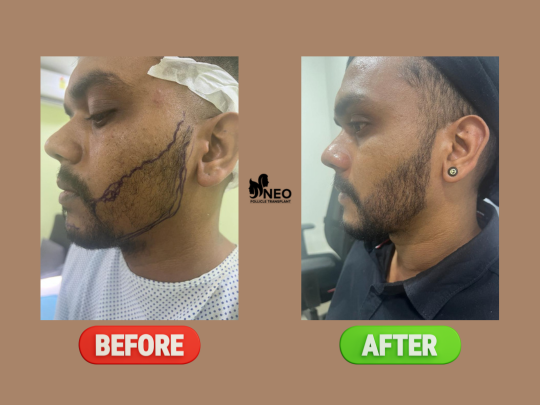Beard transplants have become a popular solution for men who struggle with patchy or uneven facial hair growth. Whether due to genetics, scarring, or hormonal imbalances, many individuals seek permanent solutions to achieve a fuller and more defined beard. In this guide, we will explore everything about beard transplants, including the techniques used, costs involved, recovery process, and post-transplant care.
What is a Beard Transplant?
A beard transplant is a cosmetic surgical procedure that involves extracting hair follicles from a donor site—typically the back of the scalp—and implanting them into the facial area where beard growth is desired. The goal is to achieve a natural-looking and permanent beard that blends seamlessly with existing facial hair.
Beard Transplant Techniques
There are two primary techniques used for beard transplantation:
1. Follicular Unit Extraction (FUE)
FUE is the most advanced and commonly used technique for beard transplants. In this method:
Individual hair follicles are extracted from the donor area (usually the back of the scalp) using a micro-punch tool.
The extracted follicles are then implanted into the beard region where hair growth is sparse.
This technique leaves minimal scarring and has a faster healing time compared to other methods.
2. Follicular Unit Transplantation (FUT)
FUT, also known as the strip method, involves:
Removing a thin strip of scalp tissue from the donor area.
Dissecting the strip into individual follicular units.
Transplanting these units into the beard region.
FUT typically results in a linear scar at the donor site but allows for a higher yield of hair follicles
Cost of a Beard Transplant
The cost of a beard transplant varies based on several factors, including location, clinic reputation, surgeon expertise, and the number of grafts required. Here’s a breakdown of cost estimates:
| Country | Average Cost (USD) |
|---|---|
| United States | $5,000 – $15,000 |
| United Kingdom | £3,000 – £7,000 |
| Canada | $4,000 – $12,000 |
| India | $1,000 – $3,500 |
| Turkey | $1,500 – $4,500 |
Factors Affecting Cost
Number of Grafts Needed: The cost increases with the number of grafts required.
Clinic Reputation & Surgeon Expertise: High-end clinics and experienced surgeons charge more.
Location: Countries like Turkey and India offer more affordable options without compromising quality.
Technique Used: FUE is generally more expensive than FUT due to its labor-intensive process.
The Beard Transplant Procedure: Step by Step
1. Initial Consultation
The surgeon assesses beard density and discusses desired results.
Determines the number of grafts required.
Reviews medical history and evaluates donor hair availability.
2. Preparation
The donor and recipient areas are cleaned and sterilized.
Local anesthesia is applied to minimize discomfort.
3. Extraction of Hair Follicles
If using FUE, follicles are extracted individually.
If using FUT, a strip of scalp is removed and dissected.
The extracted follicles are preserved in a special solution.
4. Implantation of Hair Follicles
The surgeon makes tiny incisions in the beard area.
Hair follicles are carefully implanted to mimic natural beard growth patterns.
5. Post-Procedure Care
Antibiotic ointment is applied to prevent infection.
- Instructions are given for aftercare and recovery.
Recovery and Aftercare
Immediate Post-Procedure Period (First 3 Days)
Mild swelling and redness are common.
Avoid touching or scratching the treated area.
Sleep with your head elevated to reduce swelling.
No strenuous activities or sweating.
First Week
Tiny scabs will form around the implanted follicles.
Avoid washing the beard area aggressively.
Refrain from smoking and alcohol consumption as they can hinder healing.
Two to Four Weeks
Transplanted hairs may start to shed (shock loss phase).
This is a normal part of the process before new growth begins.
Three to Six Months
Full results start becoming visible.
One Year Post-Transplant
Final results are achieved.
The beard can be trimmed and styled as desired.
Risks and Side Effects
While beard transplants are generally safe, potential risks include:
Swelling and Redness: Common but temporary.
Itching and Irritation: Can be managed with prescribed ointments.
Infection: Rare but possible if aftercare instructions are not followed.
Scarring: More likely with FUT than FUE.
Uneven Growth: Can be corrected with touch-up procedures.
Alternatives to Beard Transplants
If surgery isn’t an option, consider these alternatives:
1. Minoxidil (Rogaine)
A topical solution that stimulates hair growth.
Requires consistent use.
2. Microneedling
Uses tiny needles to stimulate hair follicles.
3. Platelet-Rich Plasma (PRP) Therapy
Injecting platelets from your blood to promote hair growth.
4. Beard Growth Supplements
Biotin, vitamins D & E, and collagen can improve hair health.
Conclusion
A beard transplant is an effective and permanent solution for achieving a fuller beard. With advancements in techniques like FUE, minimal scarring and quick recovery make it a popular choice. Understanding the costs, procedure, and recovery expectations is crucial before making a decision. For those hesitant about surgery, non-invasive alternatives like Minoxidil and microneedling may also help improve beard growth. If you’re considering a beard transplant, consult with a qualified specialist to determine the best approach for your needs.

